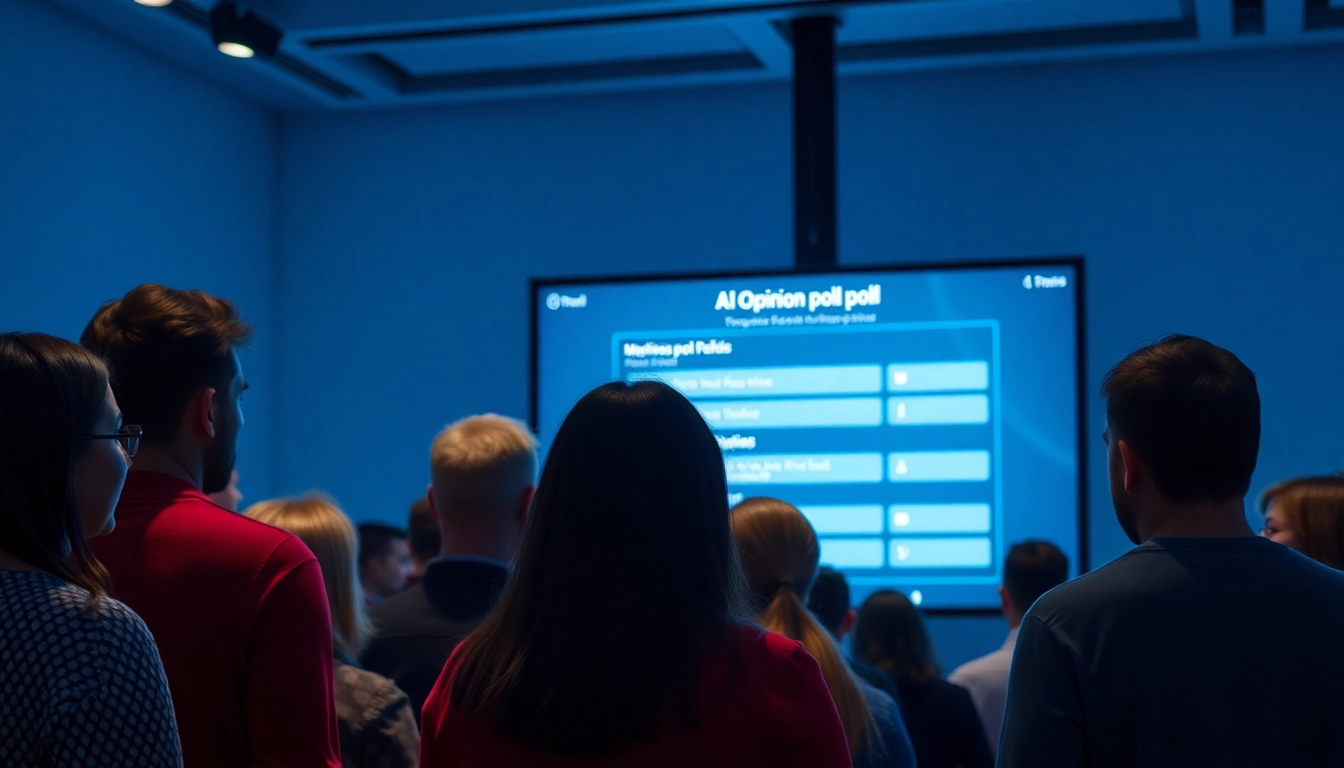Introduction to AI Opinion Polls
As artificial intelligence (AI) continues to evolve, its impact on various sectors, including public opinion polling, is becoming increasingly significant. Understanding how AI can influence and shape the perceptions of the general public is essential for businesses, political entities, and organizations looking to harness the power of data-driven insights. AI opinion polls are a cutting-edge method of gauging public sentiment and trends regarding various issues, including technology, culture, and social factors. This article will delve into the world of AI opinion polls, examining their importance, implementation, and the future landscape of public sentiment analysis.
What Are AI Opinion Polls?
AI opinion polls leverage advanced machine learning algorithms and natural language processing to collect, process, and analyze public sentiment on a range of topics. These polls typically involve gathering data from various online platforms, including social media, forums, and surveys, providing a comprehensive overview of how specific demographics feel about pertinent issues. Unlike traditional polling methods, which often sample a limited group of individuals, AI opinion polls can analyze vast amounts of data from diverse sources to yield insights that are more representative of broader public sentiment.
The Importance of AI in Polling
The integration of AI into polling processes enhances accuracy, speed, and depth of analysis. By employing real-time data collection methods, AI can capture sentiments as they evolve, allowing organizations to respond swiftly to public opinion changes. Moreover, AI’s capacity to analyze unstructured data, such as comments and discussions, helps identify underlying sentiments and nuances that conventional polling techniques might overlook. This level of insight provides decision-makers with a comprehensive understanding of the public’s emotions and thoughts, leading to more informed strategies and actions.
Overview of Current Trends in Public Opinion
Recent studies, like those conducted by Gallup and Pew Research Center, reflect a growing public skepticism about AI. Many individuals express concerns regarding its potential to displace jobs, invade privacy, and disseminate misinformation. For instance, a Gallup report indicated that a significant percentage of Americans perceive more risks than benefits associated with AI technologies. Such trends emphasize the importance of utilizing AI opinion polls to navigate these complexities, giving voice to public concerns while helping guide policy and development strategies in a rapidly changing technological landscape.
How AI Shapes Public Perception
The relationship between AI and public perception is symbiotic; AI technologies not only analyze public sentiment but also shape how that sentiment develops over time. Through targeted communication and predictive analytics, organizations can influence public discourse on AI.
The Role of AI in Understanding Feedback
AI’s capability to process large datasets allows for in-depth analysis of feedback from various demographics. By employing sentiment analysis algorithms, organizations can dissect feedback into positive, negative, and neutral categories, yielding rich insights into public perception. This understanding enables companies and policymakers to tailor their messages and initiatives in a way that resonates with the public, ultimately fostering a more constructive dialogue around AI technologies.
Analyzing Data from AI Opinion Polls
Effective analysis of data derived from AI opinion polls involves a multi-faceted approach. First, data cleaning and normalization are crucial to ensure accuracy. Following this, advanced statistical techniques and machine learning models can be applied to uncover trends and patterns. Visualization tools help present this data in an easily digestible format, facilitating better decision-making. Furthermore, analyzing sentiment over time can reveal shifts in public opinion that may correlate with significant events or changes in the AI landscape.
Case Studies: Successful Implementation of AI Polling
Several organizations have effectively utilized AI opinion polls to gain insights and drive decision-making. For instance, a political campaign might employ AI polling to gauge voter sentiment on key issues in real-time, adjusting their strategies in response to fluctuating public opinions. Another example could be brands that monitor social media for public feedback on new product launches, allowing for quick course corrections based on customer sentiment. These case studies highlight the versatility and effectiveness of AI opinion polls across various domains.
Challenges with AI Opinion Polls
Despite their advantages, AI opinion polls face various challenges that must be addressed to maximize their potential effectiveness.
Data Privacy and Ethical Considerations
As AI polls rely heavily on data collection, concerns regarding privacy and ethical usage of information are paramount. Organizations must ensure compliance with data protection regulations such as GDPR and CCPA, and maintain transparency with users about how their data will be used. Further, ethical considerations should guide the manner in which data is collected, particularly when it involves sensitive topics, ensuring that respondents’ rights and anonymity are upheld.
Misinterpretation of Poll Results
The potential for misinterpretation of AI polling results poses a significant challenge. Without proper context, data can easily be misconstrued to support misleading narratives. To combat this, organizations should provide clear reporting alongside their findings, highlighting methodology, sampling, and potential biases that might affect the results. Furthermore, effective communication strategies are essential to educate stakeholders about how to interpret the data correctly.
Addressing Public Skepticism about AI
Public skepticism towards AI presents another hurdle for effective polling. Many individuals harbor distrust towards AI technologies, often stemming from misconceptions and media portrayals. To address this issue, organizations should prioritize transparency, utilizing AI polling as an educational tool to inform the public about AI’s capabilities and limitations. Engaging with the community through open forums or workshops can also bridge the gap between apprehension and understanding, fostering a more balanced dialogue about AI.
Methods for Conducting Effective AI Opinion Polls
Successful implementation of AI opinion polls requires careful planning and execution. Below are some best practices and strategies that can enhance effectiveness.
Choosing the Right Tools and Technologies
Selecting the appropriate AI tools and technologies is fundamental to the success of opinion polling. Organizations should assess various platforms available for data collection and analysis, considering factors such as user-friendliness, scalability, and integration capabilities with existing systems. Popular tools include machine learning frameworks like TensorFlow and data visualization platforms such as Tableau, which can aid in presenting insights compellingly.
Strategies for Engaging Respondents
Engagement is critical when collecting data through AI opinion polls. Organizations should employ strategies that encourage participation, such as offering incentives or making polls easily accessible across various digital platforms. Utilizing targeting algorithms can help reach specific demographics likely to provide valuable feedback. Moreover, ensuring that the polling process is straightforward and user-friendly can enhance completion rates and data quality.
Evaluating Poll Effectiveness
Regular evaluation of polling effectiveness is vital to continuous improvement. Organizations should establish metrics to assess the accuracy and impact of their findings. This could involve comparing AI poll results with traditional polling methodologies or measuring engagement levels and respondent demographics. Feedback from participants can also provide insights into how the polling process can be enhanced.
The Future of AI Opinion Polls
The landscape of AI opinion polls is rapidly evolving, influenced by technological advancements and shifts in public sentiment. Looking ahead, significant changes are anticipated that will shape the way organizations gather and interpret public opinion.
Emerging Trends and Innovations
As AI technologies advance, new trends will emerge, enhancing polling capabilities. For instance, the use of voice recognition technology and sentiment analysis of speech could provide a more nuanced understanding of public opinions. Additionally, integrating AI with blockchain technology may enhance data integrity and transparency, addressing some privacy concerns that currently challenge polling methodologies.
Potential Impact on Decision-Making Processes
The insights gleaned from AI opinion polls will increasingly inform strategic decision-making across sectors. Organizations that can effectively interpret AI-driven insights are likely to foster more responsive and adaptive strategies, allowing them to better align their initiatives with public sentiment. Furthermore, this adaptive approach will be crucial in navigating the complex landscape of public perceptions regarding AI technologies.
How Brands Can Leverage AI Polls for Insights
Brands seeking to enhance their market positioning can leverage AI opinion polls to gain a competitive edge. By understanding emerging trends and consumer sentiments, organizations can innovate their offerings and tailor marketing strategies accordingly. Moreover, ongoing monitoring of public opinion through AI polling enables brands to react quickly to shifts in consumer preferences, ultimately fostering loyalty and trust in the long run.



